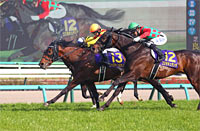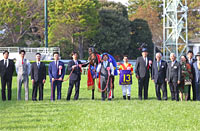Satsuki Sho (Japanese 2000 Guineas) (G1) - Data Analysis
Long-awaited first leg of the classic Triple Crown
Looking at the last 10 winners of the Satsuki Sho (Japanese 2000 Guineas), which is the first leg of the classic Triple Crown, we observe that race favorites have only triumphed twice: Victoire Pisa in 2010 and Logotype in 2013. On the other hand, the race was won by 7th favorite Captain Thule in 2008, 8th favorite Dee Majesty in 2016, and 9th favorite Al Ain in 2017, showing that poorly favored runners can also take the crown. As such, the question is how the next chapter will play out for the Satsuki Sho, a fierce race that has been contested by a large number of big names in the past. Let’s look at some useful statistics focused on performances over the last 10 years, including 2011, when the race was held at Tokyo Racecourse.
Watch previous race and corresponding finish
If we aggregate performances by runners over the last 10 years in terms of their previous race, we observe that among previous races with at least 10 runners, the group that contested the Kyodo News Hai achieved four victories, producing a high Win ratio of 40%. Among the four winners, three secured victories in the Kyodo News Hai and one finished 2nd. In addition, the group that contested in the Spring Stakes produced four Top 2 finishers, among which three won the Spring Stakes and one finished 2nd. On the other hand, of the seven Top 2 finishers that contested the Hochi Hai Yayoi Sho as their previous race, three were beaten to 3rd or lower in that race (with the remaining four notching wins). If we look only at runners that contested the Hochi Hai Yayoi Sho as their previous race, we would do well not to overlook runners that were beaten to 3rd or lower in that race.
[Table 1] Performance by previous race (last 10 years)
| Previous race |
Performance
[1st-2nd-3rd-4th or lower] |
Win ratio |
Top 2 ratio |
Top 3 ratio |
| Kyodo News Hai |
4-0-1-5 |
40.0% |
40.0% |
50.0% |
| Fuji TV Sho Spring Stakes |
3-1-2-42 |
6.3% |
8.3% |
12.5% |
| Hochi Hai Yayoi Sho |
2-5-4-33 |
4.5% |
15.9% |
25.0% |
| Mainichi Hai |
1-0-0-12 |
7.7% |
7.7% |
7.7% |
| Wakaba Stakes |
0-3-1-18 |
0% |
13.6% |
18.2% |
| Arlington Cup |
0-1-0-3 |
0% |
25.0% |
25.0% |
| Kisaragi Sho |
0-0-1-8 |
0% |
0% |
11.1% |
| Keisei Hai |
0-0-1-3 |
0% |
0% |
25.0% |
| Other races |
0-0-0-23 |
0% |
0% |
0% |
Check finish in recently contested 1,800m+ turf graded races
If we aggregate performances by runners over the last 10 years in terms of the highest finish in a 1,800m+ turf graded race contested in the previous two outings, we find that 14 of the 20 Top finishers and 19 of the 30 Top 3 finishers won the applicable 1,800m+ turf graded race. The group that finished first in such races also experienced an overwhelmingly high success ratio in the Satsuki Sho. In other words, runners that won a recent 1,800m+ turf graded race should be rated highly. [Table 2]
[Table 2] Performance by highest finish in 1,800m+ turf graded race contested in previous two outings (last 10 years)
| Highest finish |
Performance
[1st-2nd-3rd-4th or lower] |
Win ratio |
Top 2 ratio |
Top 3 ratio |
| 1st |
8-6-5-39 |
13.8% |
24.1% |
32.8% |
| 2nd |
1-1-1-27 |
3.3% |
6.7% |
10.0% |
| 3rd |
0-0-2-17 |
0% |
0% |
10.5% |
| 4th |
1-0-0-9 |
10.0% |
10.0% |
10.0% |
| 5th |
0-0-0-8 |
0% |
0% |
0% |
| 6-9th |
0-0-1-11 |
0% |
0% |
8.3% |
| 10th and lower |
0-0-0-8 |
0% |
0% |
0% |
| No such race entered |
0-3-1-28 |
0% |
9.4% |
12.5% |
Focus on favoritism in recent races
If we aggregate performances by runners over the last 10 years in terms of their lowest favoritism in the last three races, we find that runners with a lowest favoritism of “1st” in their last three outings (i.e., runners that were backed as race favorites in all three of their previous races) achieved a high Top 3 ratio of 60.0%. Runners with a lowest favoritism of “2nd” and “3rd” produced the second and third highest combined Top 2 and Top 3 ratios. Accordingly, it would seem wise to focus on runners that were Top 3 favorites in the most recent race in which they were backed with the lowest favoritism. [Table 3]
[Table 3] Performance by lowest favoritism in last three races (last 10 years)
Lowest
favoritism |
Performance
[1st-2nd-3rd-4th or lower] |
Win ratio |
Top 2 ratio |
Top 3 ratio |
| 1st favorite |
3-4-2-6 |
20.0% |
46.7% |
60.0% |
| 2nd favorite |
1-2-3-13 |
5.3% |
15.8% |
31.6% |
| 3rd favorite |
3-2-1-19 |
12.0% |
20.0% |
24.0% |
| 4th favorite |
0-1-1-18 |
0% |
5.0% |
10.0% |
| 5th favorite |
1-0-2-21 |
4.2% |
4.2% |
12.5% |
| 6th-9th favorite |
2-1-1-49 |
3.8% |
5.7% |
7.5% |
| 10th favorite or lower |
0-0-0-21 |
0% |
0% |
0% |
Trend in position when passing 4th corner in previous race
If we aggregate performances by runners in the last 10 Satsuki Sho races held at the Nakayama Racecourse since 2007 (excluding the 2011 race held at the Tokyo Racecourse) in terms of their position when passing the 4th corner in their previous race, we observe that runners in “front,” “2nd-4th,” and “5th-9th” position achieved similar Win ratios. Runners that passed the 4th corner in their previous race in “2nd-4th” and “5th-9th” position had a better Top 2 ratio, while runners in the “2nd-4th” group were the only group with a Top 3 ratio of over 20%. These could be considered useful statistics when planning bet formations. [Table 4]
[Table 4] Performance by previous race’s position when passing 4th corner (last 10 races held at Nakayama Racecourse)
Position when passing
4th corner
in previous race |
Performance
[1st-2nd-3rd-4th or lower] |
Win ratio |
Top 2 ratio |
Top 3 ratio |
| Front |
1-0-1-13 |
6.7% |
6.7% |
13.3% |
| 2nd-4th position |
5-5-6-59 |
6.7% |
13.3% |
21.3% |
| 5th-9th position |
4-4-3-48 |
6.8% |
13.6% |
18.6% |
| 10th position or lower |
0-1-0-27 |
0% |
3.6% |
3.6% |
Seek out the winner!
Watch time difference with runner-up in first victory
Among the seven winners since 2011, analysis of the time difference (margin of victory) with the runner-up in their first victory reveals that six of the seven notched their debut win 0.0-0.2s (equivalent to 1½ lengths or less) ahead of the runner-up. The remaining winner (2015 winner Duramente) notched his first win in a convincing way, 1.0 seconds ahead of the runner-up. Moreover, runners that achieved a 0.3-0.9s lead over the runner-up in their first victory have also won the Satsuki Sho numerous times in the past, but only once in the 10 years since 2008 (2010 Victoire Pisa: time difference of 0.6s). [Table 5]
[Table 5] Time difference with runner-up in first victory (last seven years)
| Year |
Winner |
Time difference with runner-up in first victory |
| 2011 |
Orfevre |
0.2s |
| 2012 |
Gold Ship |
0.0s |
| 2013 |
Logotype |
0.0s |
| 2014 |
Isla Bonita |
0.2s |
| 2015 |
Duramente |
1.0s |
| 2016 |
Dee Majesty |
0.0s |
| 2017 |
Al Ain |
0.1s |
(Michio Kawano)
|




















